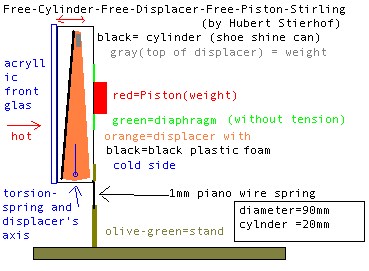Free Cylinder Free Displacer Free Piston Stirling engine
This engine design was found by chance, while testing a MC_easy design with
high resonance of the
cylinder spring and the displacer spring.
It works on approximately 6 Hertz, when heated by a 40W spot bulb from an
about 50-80mm distance.
Its stroke is about 4mm on the cylinder top and watching it, it looked like
the displacer stands still, while the cylinder
and the piston are moving.
In the seventies the english TMG (by Cooke-Yarborough) worked in a similar
manner, although it had its piston held by a
spring to the stand (as far as I remember).
At my test engine the diaphragm hangs quite loose, so it's not acting very
much like a sprin, neither to the cylinder, nor
to the stand. It's the more the inertia of the piston and the cylinder mass
acting upon each other, that makes them move.
By doing some different test runs, I've found out, that the engine:
- runs, even when an additional weight is fixed to the
cylinder
>> engines runs with about 4 Hertz and less stroke (3mm)
- runs, even when a additional weight is fixed to the piston
>> engines runs with about 6 Hertz and less stroke (3mm)
- runs, even if the cylinder spring is shorter
(higher frequency and so it's no more resonant to the displacer spring !?)
>> but it runs with a shorter stroke
- is always self-starting (as long as it's airtight)
- stops running, when the cylinder spring is too long
(lower frequency; although a higher weight doesn't stop it from running !?)
(Sorry, currently a problem urning the foto..will be corrected soon)
So, it's somewhat difficult for me to describe how the engine works, but
from my point of view(referring to the drawing),
when heated up:
- it moves the piston to the right, and by that force of inertia moves the cylinder to the left.
- by that, more air comes to the front (left hot) side and the cylinder and the piston get moved even harder....
...up to the point, where expansion ends and
- the displacer (moved by its resonant spring, which is fixed to the cylinder)
is moving (somewhat) to the front and by that
pushes the hot air somewhat back to the cold side.
- The air contracts and sucks in the piston (to the left).
But not only the piston is sucked to the left, also (by that) the cylinder
is moved (inertia) to the right and so
even more hot air moves to the cold side...
- ...up to the point, where contraction ends and the displacer (delayed)
moves to the right and pushes cold air to the front,
which causes expansion of the piston and the game starts all over again.

Although this engine might looks more like an intellectual approach to you,
it shows, that such engines, with a simpler (simplified)
displacer driving, work !!!
Even a flame-heated engine of that type is a good idea, when the stroke is kept short, or in other words:
a Free Cylinder Free Displacer Free Piston Stirling engine can be built as
a very compact 'vibrating' engine for
generating electricity....Think about it !
Hubert Stierhof